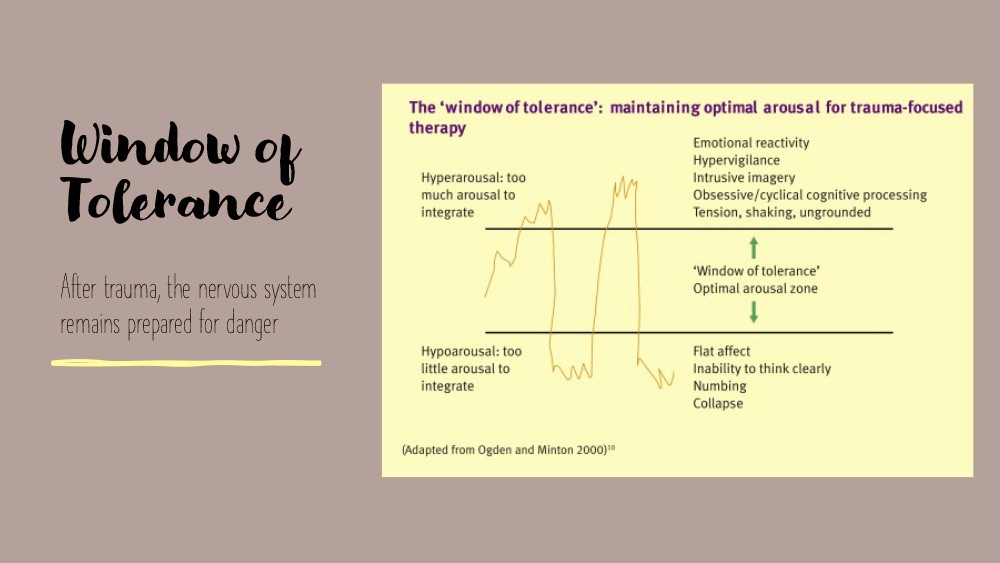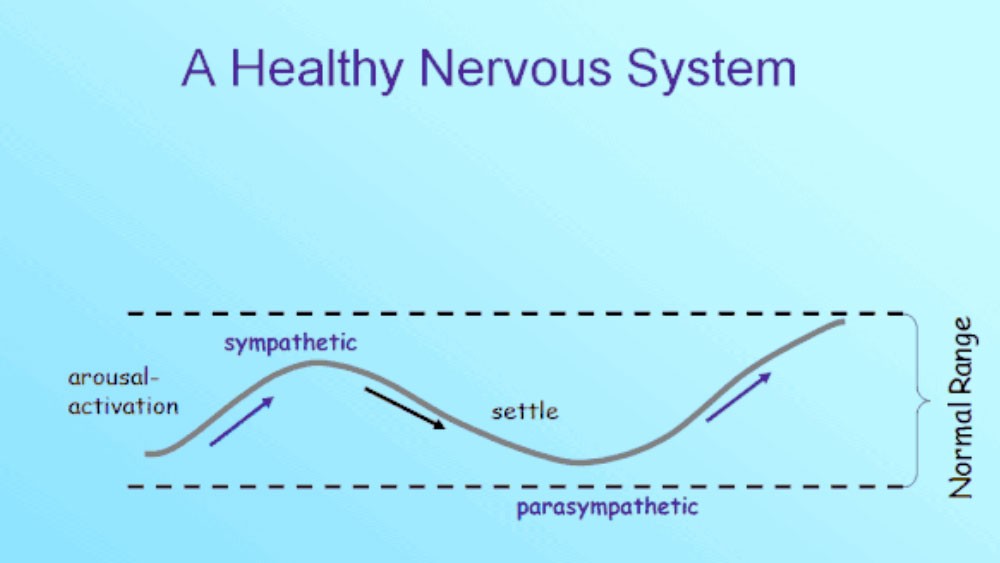Window of tolerance
During our early development if we have a healthy attachment with our parent or carer who is consistently available and nurturing, this lays very good foundations for the development of our brain and nervous system. Over time this allows us to learn how to effectively self-regulate independently.
“Window of Tolerance” is now a commonly used term in therapy to understand and describe normal brain/body reactions, especially in adverse times. When we are within the parameters of the window of tolerance, this allows for the highs and lows or ups and downs of emotions we experience, in a manageable way.

We may experience hurt, anxiety, pain or anger which brings us close to the edges of the window of tolerance but generally we are able to use strategies to keep us within this window. Similarly, we may feel too exhausted, sad, or shut down but we generally shift out of this. This means that we are functioning in the tolerable areas of the pendulum (see blog post The Pendulum). Below is a diagram demonstrating the tides of a high followed by a settling back down. This links to getting back to The Calm of The Pendulum.

(Levine, Ogden, Siegel)
When we experience a difficulty through trauma and/or unmet attachment needs this can really unbalance our nervous system. Our senses are heightened and our experiences and reactions are typically intensified and strategies are less readily accessible to us.
We see 100% of only 10% of the picture. It feels like we have 100% clarity but we are experiencing the intensity of tunnel vision. This can be overwhelming. A tough patch shrinks our window of tolerance meaning we have less capacity to ebb and flow and a greater tendency to become overwhelmed more quickly. Learning how to track and shift our affect can be a powerful tool for promoting regulation and integration in our emotional system and body.
Hyperarousal, calm arousal, and hypoarousal.
Calm arousal is the ideal state and that most times during the day we fluctuate within various levels of calm arousal. However, when we become too over-stimulated (fear, pain, anger, trauma triggers etc) to the degree that it pushes us outside of our window of tolerance this is hyperarousal.
Calm arousal is the ideal state and that most times during the day we fluctuate within various levels of calm arousal. However, when we become too over-stimulated (fear, pain, anger, trauma triggers etc) to the degree that it pushes us outside of our window of tolerance this is hyperarousal.
Hyperarousal is characterized by excessive activation/energy often in the form of anxiety, panic, fear, hypervigilence, emotional flooding etc. This keeps our system stuck on and impacts our ability to relax, often making it difficult to sleep, eat and digest food, and optimally manage our emotions. At the most intensified level this may result in dissociative rage/hostility.
With reference to my blog on bereavement, we can only tolerate so much pain, loss, anxiety, fear etc before the brain and body respond and numb us to this excessive energy. Similarly, people will only stay in a shutdown state feeling emotionally deadened inside before the brain/body shifts us out of this often by gravitating towards (often subconsciously) things that make us feel alive. For some people who have big mood swings this could mean gravitating towards high-risk behaviours or activities uncharacteristic for them to bring about a sense of excitement, activation, and vitality. This is an example of swinging quickly from the low of the pendulum into the high and why it is so important to come out of the low slowly.
Many people will describe feeling that they are not their usual self. They know that they don’t feel okay but without having experienced regulation in infancy and childhood or following unresolved traumatic experiences that remain activated in the brain and body people may grow up in a manner that they don’t know how to self-regulate. Instead, people often attempt to self-regulate and bring themselves into an optimal/calm arousal level any way that they can, without even knowing this is what they are trying to do.
For example, someone with excessive fear may gravitate towards a depressant to calm their brain and nervous system whereas someone feeling emotionally deadened may gravitate towards a stimulant to make them feel alive.
Understanding the function of how people are responding and what may be needed to effectively shift this emotional state is critical for finding effective strategies to shift arousal that don’t lead to further harm to self or others or leave the individual with a sense of shame. This can be referred to as a false refuge in that it provides the “illusion” that it is helping but in the end the problem is still there and may be even bigger now, layered with shame, guilt, a sense of failure etc.
A “true refuge” is something we do for ourselves that effectively allows us to shift towards our optimal arousal zone while building competencies and taking care of ourselves in a manner that feels good.
Parents, carers and teachers/staff can help by noticing; “It looks like you are feeling overwhelmed, why don’t we take a break” etc.
Dan Siegel refers to this as “name it to tame it”. Naming it allows for a sense of understanding and being seen as well as validation. When we stop to notice (within ourselves or others) this can be a powerful grounding tool. Children, young people and adults should be encouraged to focus mindfully on noticing how they feel, how their body feels, and identifying what they need to feel right again. Our goal is essentially to broaden this window of tolerance increasing capacity for people to hold emotional experiences (even intense ones) without become dysregulated or going into a state of hyper or hypo arousal.
Working with the window of tolerance and The Pendulum (see blog post The Pendulum) in conjunction with each other in therapy can be life changing.
If you'd like to find out more, then do get in touch and we can have an initial chat free of charge.


